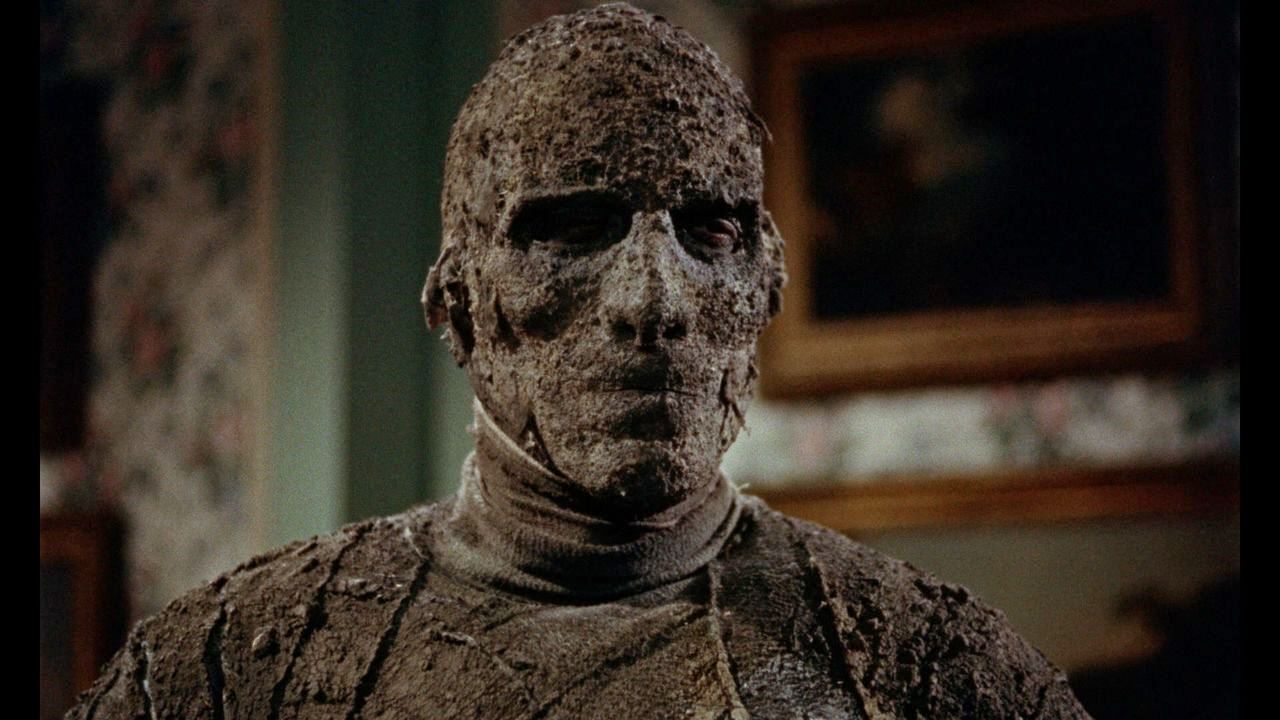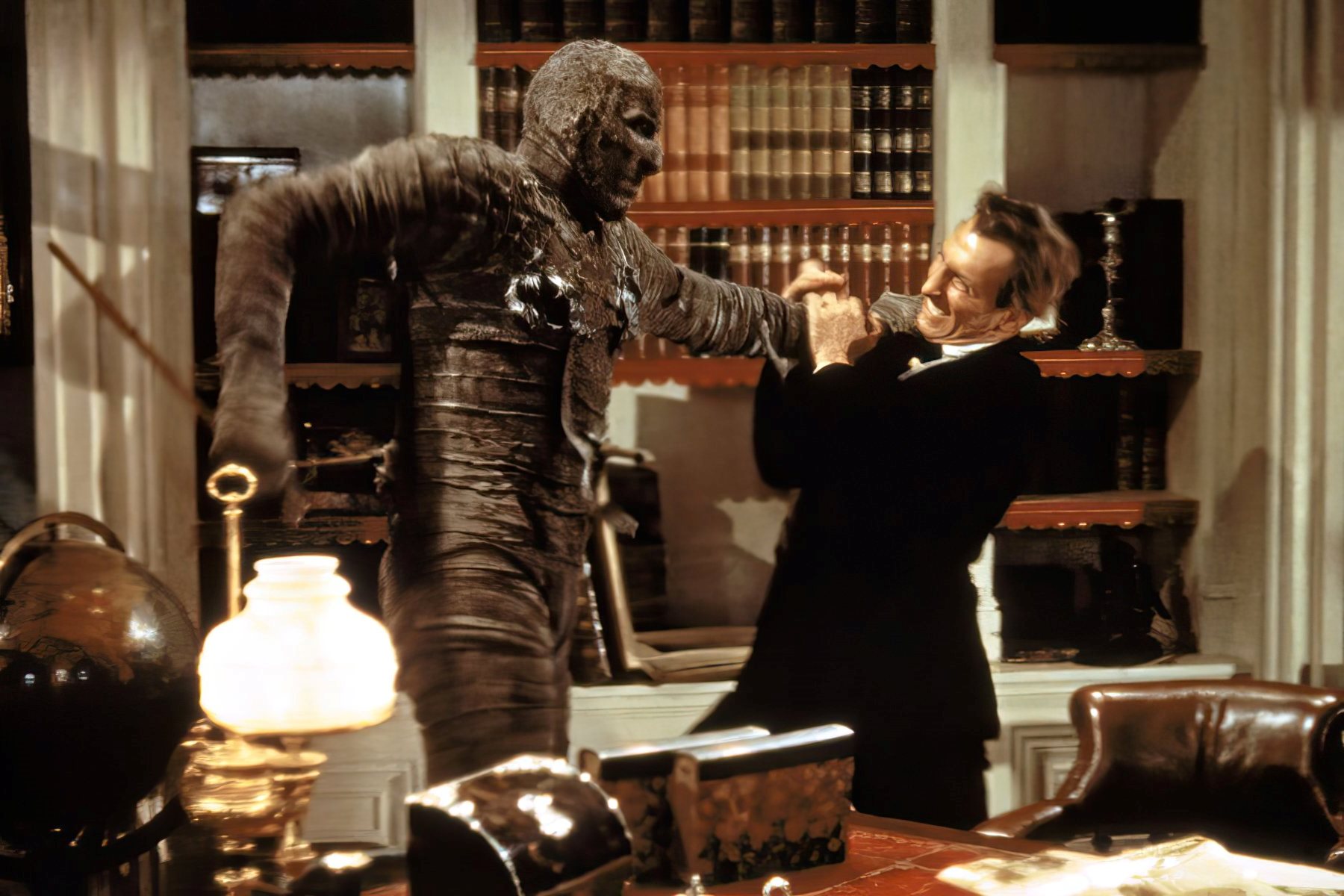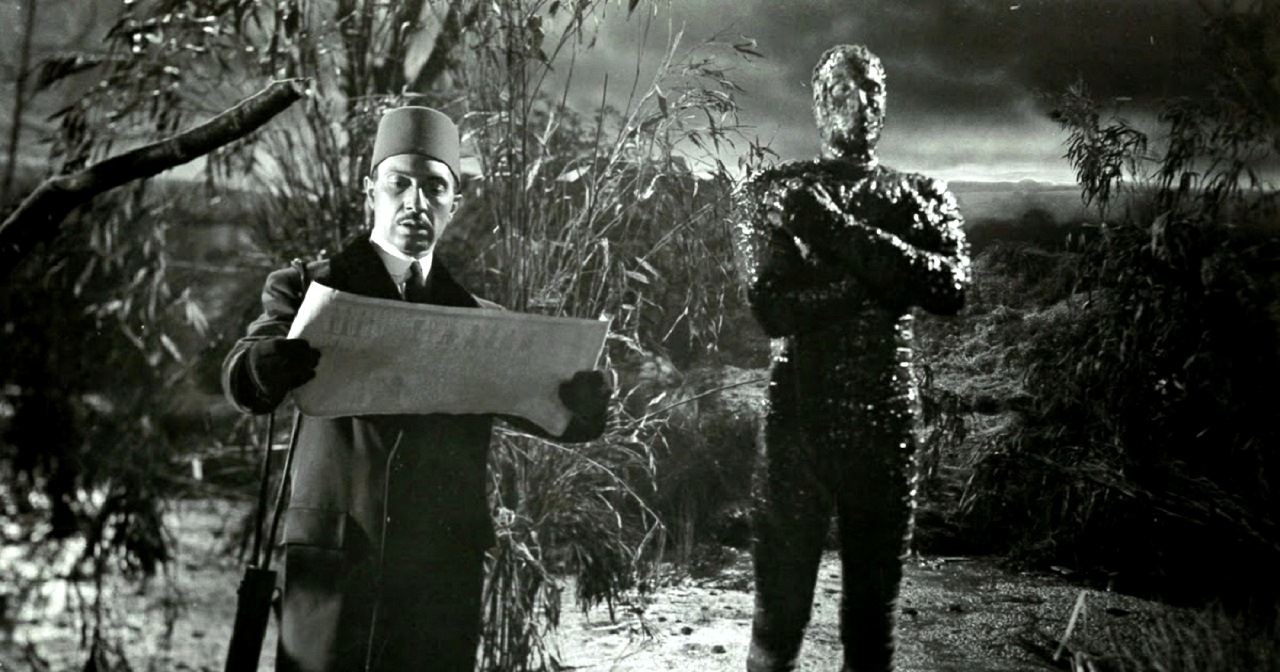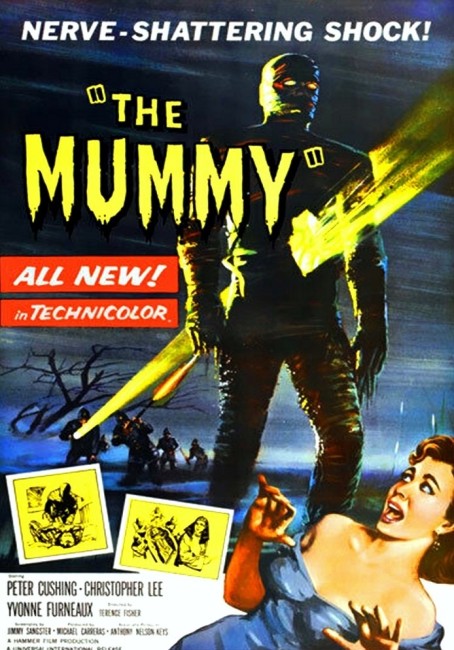UK. 1959.
Crew
Director – Terence Fisher, Screenplay – Jimmy Sangster, Producer – Michael Carreras, Photography – Jack Asher, Music – Franz Reizenstein, Special Effects – Bill Warrington, Makeup – Roy Ashton, Production Design – Bernard Robinson. Production Company – Hammer Film Productions.
Cast
Peter Cushing (John Banning), Christopher Lee (The Mummy/Kharis), Yvonne Furneaux (Isobel Banning/Princess Ananka), George Pastell (Mehemet Bey), Eddie Byrne (Inspector Mulrooney), Felix Aylmer (Stephen Banning), Raymond Huntley (Joseph Whemple), Michael Ripper (Poacher), Willoughby Gray (Dr Reilly)
Plot
In 1895, archaeologist Stephen Banning leads an expedition to Egypt that uncovers the tomb of the Princess Ananka. They open the tomb and find her mummy. Banning is later discovered having collapsed inside the tomb and in a catatonic state. Three years later in 1898, Banning’s son John has returned to England with his wife Isobel. Mehemet Bey, an Egyptian who tried to warn Stephen against opening the tomb, has bought a house nearby. Bey raises the mummy of Kharis, the high priest who loved Ananka and was cursed to be her undying guardian after he was found having broken in to the tomb in an attempt to resurrect her. Bey now sends Kharis forth to kill all of the members of the expedition for violating Ananka’s tomb.
UK’s Hammer Films had great success after making The Curse of Frankenstein (1957) and Dracula/The Horror of Dracula (1958), which gave an enormous shot of adrenalin to the British horror film and created a major new industry – for which see Anglo-Horror Films. Both of these were remakes of properties that had been filmed by Universal Studios over two decades earlier with Dracula (1931) and Frankenstein (1931), which Universal had then spun out into a series of sequels.
With the blessing of Universal Studios, Hammer then turned their attention to other classical monster properties. Over the next few years, they conducted new versions of classic tales with The Two Faces of Dr. Jekyll (1960), The Phantom of the Opera (1962), The Old Dark House (1963) and One Million Years B.C. (1966). The first of these remakes was The Mummy, which saw Hammer reuniting most of the team behind The Curse of Frankenstein and The Horror of Dracula – director Terence Fisher, screenwriter Jimmy Sangster, stars Peter Cushing and Christopher Lee, as well as cinematographer Jack Asher and production designer Bernard Robinson.
With most of their other remakes, Hammer ignored the Universal films and returned to the source work, which was usually a book. With The Mummy there was no earlier work to draw upon – the Mummy was created on screen with Universal’s The Mummy (1932), although the iconic figure of the shuffling mummy wrapped in bandages was more a creation of the Universal sequels, which consisted of The Mummy’s Hand (1940), The Mummy’s Tomb (1942), The Mummy’s Ghost (1944) and The Mummy’s Curse (1944) before the overly comedic treatment with Abbott and Costello Meet the Mummy (1955). (For a more detailed overview see Mummy Films).

About all that Hammer borrow from the Universal films is the name Kharis, which the mummy only received in the sequels. Certainly, Jimmy Sangster comes up with a plot that reshuffles many of the elements of the Universal series – the resurrected mummy; the forbidden love between mummy and princess; punishment enacted on violators of the tomb; the curse placed on the mummy; the modern day acolytes loyal to the ancient cult of the mummy; and the modern heroine who turns out to be a reincarnation of the mummy’s lost love (although technically here she is not a reincarnation, merely resembles the princess when she lets her hair down).
Certainly, Hammer give the film gorgeous colour and production value that the Universal films never had – the flashbacks to the pageantry of Ancient Egypt (even though clearly produced on cut-price sets) looks fabulous. The Ancient Egyptian flashback scenes impress with the colour and the elegance of detail.
Under the hand of Terence Fisher, The Mummy consists of one vivid scene after the other – the moment that George Pastell appears strikingly outfitted in scarlet red fez and calls the mud-covered mummy to rise up out of the steaming bog. Or where the mummy batters into the cell after Felix Aylmer, thumping on the wall and smashing its way through a grill. There is an undeniably effective scene with the ripping out of Christopher Lee’s tongue – all achieved by showing no blood at all.

There is a fabulous scene where Christopher Lee’s mummy bursts in through the doors of Peter Cushing’s study and Cushing blasts away at him with a shotgun, which takes massive chunks out of its chest, before Cushing grabs a spear and impales it straight through Lee. None of this succeeds in stopping the mummy until the door opens and Yvonne Furneaux enters and it is halted in its attack as it recognises the resemblance to the princess. Or the climax where Lee’s mummy is lured into the bog and Cushing persuades Yvonne Furneaux to get it to free her so that everyone else can shoot it down.
Fisher also has a great time with the non-dramatic schemes like where Peter Cushing pays a visit to George Pastell and sits there goading him with insults about the ignorance of the Ancient Egyptian religions, all with neither of them coming out and revealing what they know about the other.
There is an expectedly good cast, with Peter Cushing on great form. Christopher Lee gives a fine performance, lending his imposing height while managing to act entirely with his eyes poking out through the bandages. You can see just what a physical presence Lee is in the climactic scenes where he attacks Cushing and physically throws him across a chair with his hands around his neck. There is also the scene-stealing Michael Ripper as a drunken poacher who encounters the mummy.

Hammer never sequelised The Mummy but did go on to make several other mummy films with The Curse of the Mummy’s Tomb (1964), The Mummy’s Shroud (1967) and Blood from the Mummy’s Tomb (1971).
Terence Fisher’s other genre films are:– the sf films Four Sided Triangle (1953) and Spaceways (1953), The Curse of Frankenstein (1957), Dracula/The Horror of Dracula (1958), The Revenge of Frankenstein (1958), The Hound of the Baskervilles (1959), The Man Who Could Cheat Death (1959), The Stranglers of Bombay (1959), The Brides of Dracula (1960), The Two Faces of Dr. Jekyll (1960), The Curse of the Werewolf (1961), The Phantom of the Opera (1962), The Gorgon (1964), Dracula – Prince of Darkness (1966), Frankenstein Created Woman (1967), The Devil Rides Out/The Devil’s Bride (1968), Frankenstein Must Be Destroyed (1969) and Frankenstein and the Monster from Hell (1974), all for Hammer. Outside of Hammer, Fisher has made the Old Dark House comedy The Horror of It All (1964) and the alien invasion films The Earth Dies Screaming (1964), Island of Terror (1966) and Night of the Big Heat (1967).
Jimmy Sangster’s other genre scripts are:– X the Unknown (1956), The Curse of Frankenstein (1957), Dracula/The Horror of Dracula (1958), The Revenge of Frankenstein (1958), The Man Who Could Cheat Death (1959), The Brides of Dracula (1960), the psycho-thrillers A Taste of Fear/Scream of Fear (1961), Paranoiac (1963), Maniac (1963), Nightmare (1964), Hysteria (1965), The Nanny (1965) and Crescendo (1970), and Dracula – Prince of Darkness (1966), all for Hammer. Sangster’s non-Hammer scripts are the medical vampire film Blood of the Vampire (1958), the alien invasion film The Trollenberg Terror/The Crawling Eye (1958), Jack the Ripper (1959), the Grand Guignol psycho-thriller Whoever Slew Auntie Roo? (1972), the tv movie psycho-thrillers A Taste of Evil (1971) and Scream Pretty Peggy (1973), the occult tv movie Good Against Evil (1977), the occult film The Legacy (1979), the spy tv movies Billion Dollar Threat (1979) and Once Upon a Spy (1980), the psycho-thriller Phobia (1980) and the story for Disney’s The Devil and Max Devlin (1981). As director, Sangster made three films:– The Horror of Frankenstein (1970), the lesbian vampire film Lust for a Vampire (1971) and the psycho-thriller Fear in the Night (1972), all at Hammer.
Trailer here


